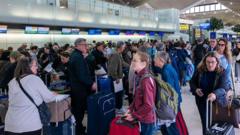Air traffic controllers at Newark Liberty International Airport faced a serious situation last week when they "lost communication" with the planes they were managing. This incident, which occurred on April 28, resulted in significant disruptions for travelers, with hundreds of flights delayed or re-routed and more than 150 cancellations reported on the following Monday alone, as cited by tracking service FlightAware.
US Transportation Secretary Sean Duffy addressed the situation, confirming that communication was lost for "30 seconds." He assured that although this was concerning, planes were safe due to auxiliary communication devices available onboard. However, he emphasized that the incident underscores the fragility of the current air traffic control system, which needs urgent improvements.
The Federal Aviation Administration (FAA) corroborated Duffy's remarks, acknowledging that their outdated system has affected workforce morale and operations. In light of the incident, multiple controllers opted for trauma leave, adding to existing staff shortages in a high-demand environment. The FAA mentioned ongoing training efforts to replace those on leave, although quick replacements remain a challenge.
The turbulence in Newark's air traffic management isn't unprecedented; United Airlines recently announced it would be cutting back 35 flights daily due to the airport's operational limitations. CEO Scott Kirby noted that technology failures by the FAA's air traffic controllers had led to additional diversions and delays over the past few days.
The National Air Traffic Controllers Association (NATCA) has reported that controllers took special leave following the traumatic event, although they did not specify the number of employees involved. Meanwhile, the US Department of Transportation aims to bolster the FAA's workforce by hiring at least 2,000 new controllers this year as part of their larger strategy to enhance operational capacity.
In efforts to remedy the situation, Secretary Duffy is preparing a proposal for Congress to secure funding aimed at overhauling the air traffic control infrastructure, which includes new technology and systems. This overhaul is crucial to address ongoing issues in the face of increasing air traffic demands across the nation.
US Transportation Secretary Sean Duffy addressed the situation, confirming that communication was lost for "30 seconds." He assured that although this was concerning, planes were safe due to auxiliary communication devices available onboard. However, he emphasized that the incident underscores the fragility of the current air traffic control system, which needs urgent improvements.
The Federal Aviation Administration (FAA) corroborated Duffy's remarks, acknowledging that their outdated system has affected workforce morale and operations. In light of the incident, multiple controllers opted for trauma leave, adding to existing staff shortages in a high-demand environment. The FAA mentioned ongoing training efforts to replace those on leave, although quick replacements remain a challenge.
The turbulence in Newark's air traffic management isn't unprecedented; United Airlines recently announced it would be cutting back 35 flights daily due to the airport's operational limitations. CEO Scott Kirby noted that technology failures by the FAA's air traffic controllers had led to additional diversions and delays over the past few days.
The National Air Traffic Controllers Association (NATCA) has reported that controllers took special leave following the traumatic event, although they did not specify the number of employees involved. Meanwhile, the US Department of Transportation aims to bolster the FAA's workforce by hiring at least 2,000 new controllers this year as part of their larger strategy to enhance operational capacity.
In efforts to remedy the situation, Secretary Duffy is preparing a proposal for Congress to secure funding aimed at overhauling the air traffic control infrastructure, which includes new technology and systems. This overhaul is crucial to address ongoing issues in the face of increasing air traffic demands across the nation.



















